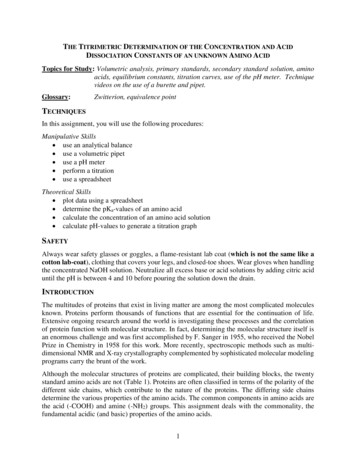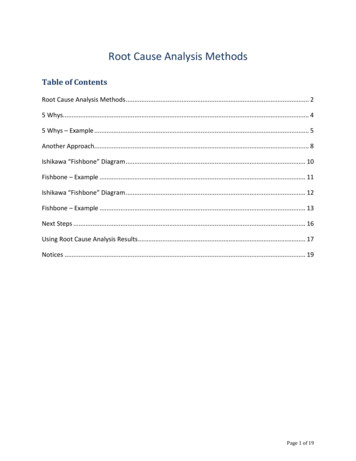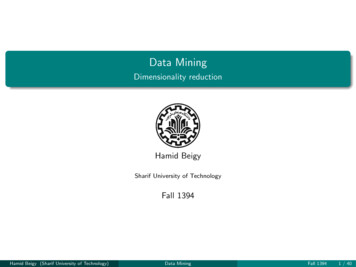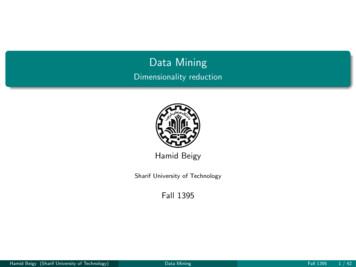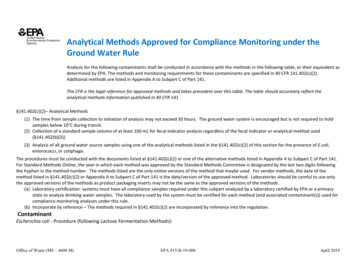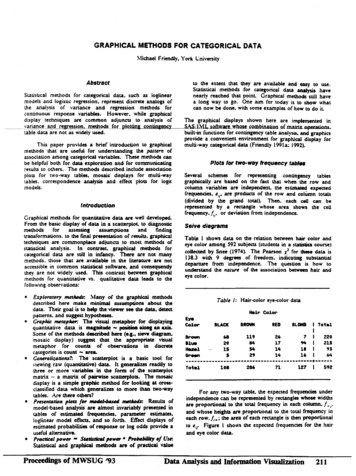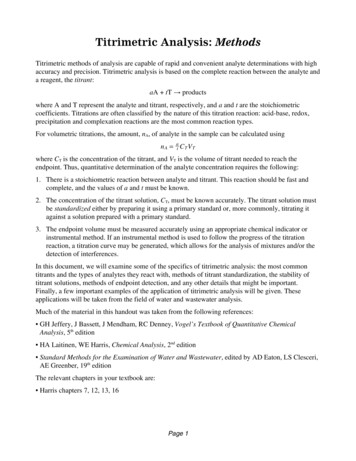
Transcription
Titrimetric Analysis: MethodsTitrimetric methods of analysis are capable of rapid and convenient analyte determinations with highaccuracy and precision. Titrimetric analysis is based on the complete reaction between the analyte anda reagent, the titrant:aA tT t productswhere A and T represent the analyte and titrant, respectively, and a and t are the stoichiometriccoefficients. Titrations are often classified by the nature of this titration reaction: acid-base, redox,precipitation and complexation reactions are the most common reaction types.For volumetric titrations, the amount, nA, of analyte in the sample can be calculated usingn A at C T V Twhere CT is the concentration of the titrant, and VT is the volume of titrant needed to reach theendpoint. Thus, quantitative determination of the analyte concentration requires the following:1. There is a stoichiometric reaction between analyte and titrant. This reaction should be fast andcomplete, and the values of a and t must be known.2. The concentration of the titrant solution, CT, must be known accurately. The titrant solution mustbe standardized either by preparing it using a primary standard or, more commonly, titrating itagainst a solution prepared with a primary standard.3. The endpoint volume must be measured accurately using an appropriate chemical indicator orinstrumental method. If an instrumental method is used to follow the progress of the titrationreaction, a titration curve may be generated, which allows for the analysis of mixtures and/or thedetection of interferences.In this document, we will examine some of the specifics of titrimetric analysis: the most commontitrants and the types of analytes they react with, methods of titrant standardization, the stability oftitrant solutions, methods of endpoint detection, and any other details that might be important.Finally, a few important examples of the application of titrimetric analysis will be given. Theseapplications will be taken from the field of water and wastewater analysis.Much of the material in this handout was taken from the following references: GH Jeffery, J Bassett, J Mendham, RC Denney, Vogel’s Textbook of Quantitative ChemicalAnalysis, 5th edition HA Laitinen, WE Harris, Chemical Analysis, 2nd edition Standard Methods for the Examination of Water and Wastewater, edited by AD Eaton, LS Clesceri,AE Greenber, 19th editionThe relevant chapters in your textbook are: Harris chapters 7, 12, 13, 16Page 1
Titrimetry MethodsAcid-Base TitrationsAqueous Acid-Base TitrationsGeneralProton transfer reactions in aqueous solutions are quite fast. Aqueous acid-base titrations are thussuitable for the analysis of any Bronsted acid or base. Practically, the pKa or pKb of the analyte shouldbe less than about 10 (i.e., pKa or pKb 10) for a complete reaction between analyte and titrant.Common TitrantsIn order for the titration reaction to go to completion, a strong acid or a strong base is the usual choicefor a titrant in acid-base titrations. The levelling effect in aqueous solutions should be kept in mind,however: the strongest acid that can exist at a substantial concentration is the hydronium ion, H3O ,since any strong acid HA will react completely with water:HA H2O t A– H3O Thus, titrating with any strong acid is equivalent to titrating the analyte with hydronium ion.Similarly, the strongest base that can exist in water is the hydroxide ion, OH–.For the analysis of bases, the most common aqueous titrant is HCl; sometimes H2SO4 or HClO4 arealso used. Any of these may be standardized by tris(hyddroxymethyl)aminomethane, (HOCH2)3CNH2,which is sometimes referred to simply as tris. Sodium carbonate, Na2CO3, can also serve as a primarystandard, but it is less desirable than tris due to its lower equivalent weight. Titrations of bases aresometimes called alkalimetric titrations.For the analysis of acids, NaOH is usually used; KOH or Ba(OH)2 may also be used. Any of thesemay be standardized against potassium hydrogen phthalate (KHP). The hydrogen phthalate anion isshown below.OOHOOTitrations of acids are sometimes called acidimetric titrations.Any alkaline solution will absorb substantial amounts of carbon dioxide from the atmosphere,resulting in the following net reaction:CO2 2OH– l CO32– 2H2OPage 2
Exposure of aqueous NaOH or KOH titrant to the atmosphere results in carbonate error. Solidhydroxide salts may also contain significant amounts of carbonate impurities due to absorption ofatmospheric CO2. A NaOH titrant solution is best prepared by dilution from a concentrated(approximately 50 w/w%) solution. Sodium carbonate is insoluble in this solution. The diluted titrantsolutions are sometimes boiled to drive dissolved CO2 out of the solution and then protected fromexposure to air. The absorption process is fairly slow, occurring over a period of hours and days.Ideally, acidimetric titrations should be performed with a freshly prepared and standardized solutionof NaOH.Nonaqueous Acid-Base TitrationsGeneralSometimes acid-base titrations are performed using a solvent other than water. There are severalreasons why nonaqueous acid-base titrations may be used instead of aqueous titrations:1. The sample is insoluble in water.2. Sample and/or titrant reacts with water in undesirable ways.3. For the analysis of very weak acids or bases. As mentioned previously, an aqueous acidimetrictitration is limited to bases with pKb less than about 10. Otherwise, the reaction between titrant(i.e., H3O ) and analyte will be incomplete. One solution to this problem for weak bases would beto use a stronger titrant – an impossibility in aqueous solutions. However, using glacial acetic acidas the solvent would solve that problem, since the strongest possible acid is H2OAc (a strong acidindeed). Most strong acids do not completely dissociate in acetic acid. Thus, perchloric acid inacetic acid is a much stronger titrant than the same acid in water. Similar considerations apply toalkalimetric titrations.4. Selectivity is sometimes enhanced in nonaqueous solutions (analysis of analytes with similardissociation constants). In aqueous solutions, a difference of 2 pK units is necessary to observedistinct endpoints. However, careful choice of solvent can sometimes allow the observation ofdistinct endpoints that cannot be measured in aqueous solution.Common Titrants for Nonaqueous Acid-Base TitrationsAlkalimetry in Nonaqueous Solutions HCl in isopropanol HClO4 in glacial acetic acid these titrants may be standardized by tris, just as in aqueous titrationsAcidimetry in Nonaqueous Solutions KOH in ethanol, methanol, or isopropanol sodium methylate, NaOCH3, in methanol or chlorobenzenePage 3
nonaqueous alkalimetric titrants may usually be standardized by benzoic acid, which is soluble inmost of the solvents commonly usedInstrumental Endpoint Detection in Acid-Base TitrationsPotentiometric endpoint detection using a pH meter is the universal instrumental method used foracid-base titrations, both in aqueous and nonaqueous solvents. Special care of the pH electrode isnecessary for nonaqueous titrations – in particular, the electrode must not be allowed to becomedehydrated.Example Applications of Acid-Base TitrationsKJeldahl Analysis of Organic NitrogenThe Kjeldahl procedure is a method for the analysis of organic nitrogen in the –3 oxidation state. Thesample is digested with sulfuric acid to convert the organic nitrogen to ammonium, NH4 . Thedigested sample is then basified and ammonia is then distilled into acid. The ammonia may bedistilled into excess standard HCl; the amount of HCl remaining after the distillation is determined byalkalimetric titration. Alternately, ammonia may be distilled into excess boric acid, H3BO3; thedihydrogen borate, H2BO3–, formed by reaction with ammonia is determined by acidimetric titration.The following figure shows apparatus that can be used for Kjeldahl analysis.Page 4
Kjeldahl analysis is often used in the analysis of surface water and wastewater. The total Kjeldahlnitrogen (TKN) content of a water sample is a measure of the total concentration of nitrogen in the–3 oxidation state in the sample: ammonia/ammonium plus organic nitrogen. Kjeldahl analysis is alsowidely used to determine the protein content of food samples.Buffering of Natural WatersThe ability of an aqueous solution to resist changes in pH upon the addition of acid or base is termedthe buffering capability of the solution. The ability of a natural water body to resist a decrease in pHis very important due to the ubiquitous presence of acid rain. The alkalinity of a water body isdefined as the number of moles of H needed to bring a 1L sample to pH 4.5. The higher the acidneutralizing capacity (ANC) of the water, the more acid must be added to the 1L sample to bring thepH to 4.5.Acidimetric titration to pH 4.5 (rather than to an endpoint) is thus widely used to characterize theability of a water body to resist acidification. If potentiometric detection is not used, bromcresol green(perhaps mixed with methyl red) is used as a chemical indicator; the color change signifies the end ofthe titration.Page 5
Titrimetry MethodsPrecipitation TitrationsPrecipitation reactions in aqueous solution range from rapid to slow, depending on the identity of theprecipitant. Many precipitations are sufficiently rapid and complete to form the basis of quantitationby titration. Precipitation titrimetry has several advantages over precipitation gravimetry, includingspeed, sensitivity, and convenience.Common TitrantsArgentometric TitrationsMost precipitation reactions involve the silver cation, Ag . Silver precipitations are rapid andquantitative, and silver nitrate, AgNO3, is used for the direct titration of a number of anions thatprecipitate silver: all the halides except F–; SCN–, CNO–, AsO43–, PO43–, CN–, C2O42–, CO32–, S2–,CrO42–. See table 7-1 on page 167 in Harris for more detail. Titrations using AgNO3 as titrant aretermed argentometric titrations.Sodium chloride is suitable as a primary standard, and is most often used for standardization of thetitrant in argentometric titrations. Solid silver nitrate is also available in high enough purity to serveas a primary standard, but it is more expensive.Silver nitrate solutions are stable in the dark, and amber bottles are used for storage. Exposure to lightcan cause photoreduction of the silver cations, particular in the presence of trace impurities that maycatalyze the reaction.Sulfate AnalysisThe sulfate content of an aqueous solution may be determined by titration with aqueous bariumchloride, BaCl2. The titrant is usually standardized using sodium sulfate.Fluoride AnalysisFluoride cannot be analyzed by argentometric titration (AgF is soluble); instead, the sample may betitrated with lanthanum nitrate, La(NO3)3, or lead nitrate, Pb(NO3)2, since both LaF3 (pKsp 16.2) andPbF2 (pKsp 7.57) are insoluble. Sodium fluoride is a suitable primary standard.Endpoint DetectionA variety of chemical indicators are used to indicate the endpoint of argentometric titrations: theFajans, Volhard, and Mohr methods are discussed in some detail in the lab handout TitrimetricAnalysis of Chloride, and in your textbook (Harris chapter 7).A silver wire or ring is a sufficient indicator electrode for potentiometric titrations using AgNO3,while a fluoride ISE is suitable for potentiometric endpoint detection for fluoride analysis using La3 or Pb2 titrant solutions.Page 6
Example Application: Analysis of Chloride in Surface WatersChloride is frequently a major anion in surface and groundwater; certainly is a major constituent ofseawater. Although chloride in freshwater is usually of geological origin, runoff from roads saltedduring the winter may significantly increase the chloride content of surrounding streams, rivers andlakes. A high chloride concentration may impart a noticeably salty taste to potable water, and can alsodamage metallic pipes and growing plants.Argentometric titration of water samples is a standard method for chloride determination;concentrations in the low ppm range may be detected using potentiometric titration.Page 7
Titrimetry MethodsRedox TitrationsRedox reactions are the most diverse of the four main classes of inorganic aqueous reactions(acid-base, pptn, complexation and redox). In principle, then, redox titrations can be used to analyzefor any oxidizing or reducing agent. However, many redox reactions are either too slow or haveinconsistent stiochiometry. The stability of titrant and analyte solutions can also be a problem.Nevertheless, a wide variety of analytes can be conveniently determined by redox titrations.General ConsiderationsConsider a generic redox half-reaction (charges omitted for clarity):ox ne– l redA chemical (i.e., ox in this equation) that pulls electrons from another substance is an oxidizingagent, while a chemical (red) that forces another substance to accept electrons is a reducing agent.Together, ox/red form a redox couple; redox couples are analogous to acid/base conjugate pairs. Andjust like acid-base reactions, the “conjugate” of a strong oxidizing agent is a weak reducing agent.The strength of oxidizing/reducing agents can be deduced by the standard reduction potential: a verypositive standard potential indicates a strong oxidizing agent, while a low positive or a negativepotential is characteristic of a strong reducing agent.The strength of an oxidizing or reducing agent is very often dependent on pH. There is a general ruleof thumb: acidic conditions tend to make oxidizing agents more powerful and render reducing agentsless reactive. Some few redox reagents are relatively insensitive to pH, which can be an advantage.Most redox reagents are stable (if they are stable at all!) only within a certain pH range.Sample treatment is often necessary to adjust the oxidation state of the analyte. The analyte is eitherpre-reduced or pre-oxidized. For pre-reduction of the analyte, many metals (many of which are strongreducing agents) can be used. It is common to use a reductor, which is a column of granulated metalthrough which the sample solution is poured. Two common reductors are: the Jones Reductor, whichuses amalgamated zinc (ZnHg) granules, and the Walden Reductor, which uses silver granules(chloride is added to the sample, usually as HCl). The Walden Reductor is more selective (i.e., a lesspowerful reducing agent) than the Jones Reductor.Pre-oxidation is not as common as pre-reduction, since the analyte is usually desired in a reducedform for titration with an oxidizing agent. However, when pre-oxidation is necessary, sodiumbismuthate, NaBiO3, ammonium peroxydisulfate, (NH4)2S2O8, or hydrogen peroxide may be used.Common TitrantsReducing Agents reducing agents are not stable in air (undergo air oxidation) and so are not often used. Here are afew titrantsPage 8
the two most common reducing titrants are ferrous ammonium sulfate (FAS) and sodiumthiosulfate. Procedures using these titrants are capable of determining the concentrations analytesthat are (at least) moderately strong oxidizing agents.Ferrous Ammonium Sulfate (FAS or Mohr’s salt), (NH4)2Fe(SO4)2 the ferrous ion is a fairly weak reducing agent:Fe2 t Fe3 e–E 0.771VThe use of ferrous ion as a titrant is limited to the analysis of moderately strong oxidizing agents; itis used for the direct titration of a few metals such as U(VI), Mo(VI) and V(IV). Probably the mostimportant use of FAS is in back-titrations of dichromate and other reasonably strong oxidants. solutions of FAS are most stable under acidic conditions (in 0.5M H2SO4); still, the solution isstable only for about a day. Standardization is with potassium dichromate, K2Cr2O7.Sodium Thiosulfate, Na2S2O3 thiosulfate is a moderately strong reducing agent:2S2O32– t S4O62– 2e–E 0.09 V thiosulfate is actually not suitable for the direct analysis of most oxidizing agents, since reactionswith thiosulfate tend to produce also produce sulfite and sulfate. However, it is widely used inback-titrations of iodine that is produced by the reactions of oxidizing agents with iodide, anotherreducing agent (this procedure is called iodometry). thiosulfate solutions are standardized with iodine which has been prepared by acidifying primarystandard potassium iodate in the presence of a slight excess of potassium iodide:acidic solutionIO3– 5I– 6H t 3I2(aq) 3H2OThe titration reaction between iodine and thiosulfate is fairly straightforward:I2 2S2O32– t 2I– S4O62– alkaline solutions of sodium thiosulfate are fairly stableOxidizing Agents used for the analysis of reducing agents. Pre-reduction of analyte is common; analyte is oftenunstable in reduced form, and care must be taken in sample handlingPotassium Permanganate, KMnO4 used since the mid-1800’s - one of the earliest titrimetric agents a strong oxidantMnO4– 4H 3e– t MnO2(s) 2H2OE 1.692 V standardized with sodium oxalate, Na2C2O4. Not a very stable titrant unless precautions are taken;should be standardized fairly often.Page 9
can be used for the analysis of many reducing agents, weak or strong. Examples are given in table16-3 in Harris: e.g., Br–, H2O2, NO2–, Fe2 , As3 , Sb3 , Mo3 , W3 , U4 , Ti3 Ceric Sulfate, Ce(SO4)2 another strong oxidant, just about as strong as permanganateCe4 e– t Ce3 E 1.44 V (in H2SO4) standardized with Na2C2O4. Alternately, primary standard (NH4)2Ce(NO3)6 can be used (expensive!).Titrant is very stable in acid solutions; it ppts in alkaline solutions. almost anything that can be done with potassium permanganate can be done more conveniently withceric sulfate.Potassium Dichromate, K2Cr2O7 historically important; like permanganate, used since mid-1800’s a moderately strong oxidizing agent; oxidizing ability depends strongly on pH, decreasing rapidly assolution becomes more neutralCr2O72– 14H 6e– t 2Cr3 7H2OE 1.36 V available in sufficient purity to be its own primary standard; in fact, it is the most common reagentused to standardize reducing titrants. If necessary, dichromate solutions can be standardized withNa2C2O4. most common applications: analysis of iron content of ores and COD of wastewaters. Advantage foriron ore analysis: no problem with HCl solutions, unlike permanganate (which oxidizes chloride tochlorine). Back-titrations involving FAS are also common: FAS may be added in excess for theanalysis of oxidizing agents (back-titration with dichromate) or FAS may be used for to analyzeexcess dichromate (as in COD measurements).Titrations involving Iodine, I2General Applicability an important class of techniques: can be used to analyze moderately strong oxidants or reductants.Advantage of moderate strength as a redox reagent: better selectivitity. Permanganate and cericoxidize almost everything present. the standard reduction of iodine isI2(aq) 2e– t 2I–E 0.621 V iodine is a moderate oxidizing agent; iodide is a moderate reducing agent. There are two classes oftitrations involving iodine:1. Iodimetry, which is based on the direct reaction between the analyte and iodine. Since iodine is anoxidizing agent, iodimetry is used for the analysis of reductants.Page 10
2. Iodometry, which is based on the reaction between the analyte and an unmeasured excess ofiodide to produce iodine, which is measured by titration with thiosulfate. The amount of iodineproduced by this reaction is stoichiometrically related to the amount of analyte originally presentin the solution. Since iodide is an reductant, iodometry is used for the analysis of oxidants. applications of iodimetry and iodometry are extensive; see Harris table 16-4 for more details.Remember: iodimetry (analyte reacts with iodine) is for the analysis of reducing agents, whileiodometry (production of iodine by reaction of analyte with iodide, followed by back-titration withthiosulfate) is for the analysis of oxidizing agents. Titrations involving iodine are more selectivethan those involving more powerful redox reagents.Iodine Aquatic ChemistryIodine crystals are only sparingly soluble in water, so the standard potential listed earlier for iodinegives a misleading impression of the strength of iodine as an oxidizing agent. Usually iodine isprepared by dissolution in a solution of concentrated potassium iodide, due to the formation of thetriiodide ion:I2(aq) I– l I3–K 710This reaction allows iodine to dissolve. However, the actual concentration of I2(aq) remains low; thus,the oxidizing power still does not approach that of 1M I2(aq). Due to the presence of triiodide, thefollowing reaction is often used to represent iodine oxidation during a titration:I3–(aq) 2e– t 3I–(aq)E 0.545 VThe oxidizing ability of iodine solutions is not very dependent on pH; however, in alkaline solutions(pH 8), iodine disproportionates to iodate and iodide:alkaline solution3I2 3H2O l IO3– 5I– 6H Note that this reaction is quite reversible: upon acidification, the reaction shifts to the left as iodatereacts with iodide to form iodine.Preparation of Titrant Solutions iodine titrant solutions are usually prepared by dissolving solid iodine in potassium iodide solutions.The solution may be standardized with primary standard sodium oxalate or with sodium thiosulfatethat has been previously standardized. sodium thiosulfate is the reducing agent that is universally used for the back-titration of iodineproduced in iodometry. This titration reaction is stoichiometric and fairly rapid:I2 2S2O32– t 2I– S4O62– sodium thiosulfate titrant is prepared simply by dissolving the salt in water and storing underslightly basic conditions. It is standardized with potassium iodate that has been acidified in excessiodide.Iodine/triiodide solutions are unstable for a variety of reasons. First of all, aqueous iodine exerts asignificant vapor pressure. Also, under acidic conditions iodide is slowly air-oxidized to produceiodine. Finally, under alkaline conditions, iodine will disproportionate to produce iodide and iodate,Page 11
as mentioned previously. Thus, iodine solutions are generally most stable at neutral pH values. Iodinetitrant solutions must be standardized fairly frequently.Endpoint Detection for Redox Titrations it is probably worthwhile to mention that starch is an excellent chemical indicator for titrationsinvolving iodine potentiometric detection with an inert indicator electrode (e.g., Pt) is a general method for followingredox titrations amperometric detection can also be used in many cases many redox titrants are colored (e.g., permanganate or iodine) and so photometric detection can alsobe used to follow the course of the titrationApplications of Redox TitrationsExample Applications DO by Winkler (iodometric) titration COD by dichromate back-titration (using FAS) analysis of iron in ores by dichromate titration analysis of residual chlorine by iodometric titration analysis of ascorbic acid (vitamin C), hydrogen peroxide, bleach, .Summary of Applications of Redox Reactions analytes that are oxidizing agents are most conveniently analyzed by addition of excess reducingagent and then back-titrating. There are two common ways of doing this: (i) addition of a measuredexcess of ferrous ammonium sulfate and back-titrating the unreacted excess with dichromate titrant;(ii) addition of an unmeasured excess of potassium iodide and using thiosulfate to back-titrate theiodine produced by reaction of iodide with analyte. analytes that are reducing agents may be analyzed by a variety of oxidizing agents: potassiumpermanganate and ceric sulfate are strong oxidants, potassium dichromate is a moderately strongoxidizing titrant (especially suitable for the analysis of ferrous iron, or back-titrations with FAS) andiodine is a milder, more selective oxidizing agent that may be used for the direct analysis of anumber of reducing agents (iodimetry), as well as the indirect analysis of reducing agents(back-titration with thiosulfate in iodometry; see above) pre-treatment of the analyte with an oxidizing agent or a reducing agent is often needed in redoxtitrationsPage 12
Titrimetry MethodsEDTA TitrationsGeneral Scope and Applicability of EDTA TitrationsComplexometric titrations are based on the reaction between Lewis acids (usually metal cations) andLewis bases.M :L t M:LLewis acids and bases react to form a complex. The base donates two electrons to form a bond withthe acid. Since the proton, H , is a good Lewis acid, by definition any Bronsted base will be a Lewisbase. Lewis bases will possess at least a single lone pair of electrons that it will donate to the Lewisacid. Lewis bases are also sometimes called ligands, and the atoms containing the lone pair is theligand binding site.A special subset of ligands are those that contain more than one binding site on the molecule; theseare called chelating agents. Chelating agents form particularly strong complexes – called chelates –with Lewis acids. By far the most common complexometric titrant is ethylenediaminetetraacetic acid,EDTA. This is a hexadentate chelating ligand, meaning that there are six ligand binding sites onEDTA molecule. EDTA titrations are very versatile: they can be used for the analysis of all the metalcations except the alkali metals, and can even be used (through back-titration and similar methods)for the analysis of many anions. EDTA titrations are also fairly sensitive, capable of detectingconcentrations of some metals at levels of approximately 10 ppm (i.e., 10 mg/L).EDTA ChemistryAdvantages of EDTA as a Complexing TitrantComplexation of metal cations with unidentate ligands is not useful as the basis for a quantitativetitration. Let’s imagine that we have a solution of Cu2 to be analyzed by complexometric titration.We can use a titrant such as aqueous ammonia, a unidentate ligand. The following equations show thestepwise formation of complexes between the metal and the ligand:Cu2 NH3 l CuNH32 CuNH32 NH3 l Cu(NH3)22 Cu(NH3)22 NH3 l Cu(NH3)32 Cu(NH3)32 NH3 l Cu(NH3)42 logK 3.99logK 3.34logK 2.73logK 1.97Since the coordination number of Cu2 , ideally we would observe four distinct endpoints during thetitration with NH3. The following figure shows the titration curve that would actually be observed.Page 13
Complexometric Titration:Titration of 0.10 M Cu2 with 0.10 M NH39876pCu5432100100200300400500600volume added titrant, mLThe dashed lines indicate the equivalence points for the four complexation reactions. However, theequilibrium constants of those reactions are not different enough to observe four distinct endpoints. Inaddition, the equilibrium constants themselves are not large enough for the titration; we would likethe complexation to go more to completion.As mentioned previously, EDTA is a hexadentate chelating agent. The structure of the neutral EDTAmolecule is given below.OHOONOOHNOOHOHethylenediaminetetraacetic acid(EDTA)The two nitrogen atoms contain lone pairs that can be donated to the metal cation. In addition, a metalcation can displace the proton on the four carboxyl acid groups. The structure of an EDTA-metalchelate is illustrated in the next figure for a metal (M) that has a coordination number of six. TheEDTA forms a “cage” around the metal cation, binding the metal with the two amine nitrogens andthe four carboxylate groups.Page 14
Compared to unidentate ligands, EDTA has two very important advantages as a titrant:1. It reacts with most metal cations (as long as the coordination number is six or less, which is trueof most metals) in a 1:1 stoichiometry, meaning that only a single endpoint will be observed.2. It complexes very strongly to almost every metal (see table 13-2 in Harris, p313). This means thatthe endpoint of the EDTA titration will be sharp.The following is the titration curve that would be observed in titrating the same Cu2 solution withEDTA instead of aqueous ammonia. Obviously this titration is much better suited for the quantitativeanalysis of the copper in the solution.Complexometric Titration:Titration of 0.10 M Cu2 with 0.10 M EDTA20pCu151050020406080100120140160180200volume added titrant, mLEDTA is a hexaprotic acid (as it must be, since it is a hexadentate ligand and H is a Lewis acid). Thedissociation constants of EDTA are: pKa 0.0, 1.5, 2.0, 2.66, 6.16, 10.24. The neutral form of EDTAis usually abbreviated as H4Y. The dominant uncomplexed form of EDTA will depend on the pH, asshown in the following table.Page 15
pHdominant0 – 1.5H5Y 1.5 – 2.0H4Y2.0 – 2.66H3Y–2.66 – 6.16H2Y–6.16 – 10.24HY3– 10.24Y4–The chemical equation for the reaction of EDTA with a metal cation is often written as that betweenthe fully deprotonated form of EDTA and the cation. For example, the titration equation for thereaction between Cu2 and EDTA is generally written asCu2 Y4– t CuY2–regardless of which form of EDTA is dominant at the pH of the sample solution. The equilibriumexpression for this reaction is:KT [CuY 2 ][Cu 2 ][Y 4 ]This is not to say that a metal cation can only react with the deprotonated form of EDTA. Forexample, at a pH of 7, the following reaction would certainly occur:Cu2 HY3– t CuY2– H We will soon discuss the effect of pH on the titration in more detail.Preparation and Standardization of EDTA SolutionsThe neutral EDTA molecule (H4Y) is not very soluble in water, so that aqueous EDTA titrantsolutions are usually prepared by dissolving the disodium (Na2H2Y) or magnesium (MgH2Y) salt ofEDTA. The concentration of free EDTA in the solution is decreased by contamination of the solutionby metals that may be present in normal glassware. EDTA titrant solutions are generally stored inpolyethylene or borosilicate glass containers. A fresh solution should be prepared at least monthly,and the solution should be standardized fairly often (every one or two weeks) against using calciumcarbonate, which is
In order for the titration reaction to go to completion, a strong acid or a strong base is the usual choice for a titrant in acid-base titrations. The levelling effect in aqueous solutions should be kept in mind, however: the strongest acid that can exist at a substantial concentration is the hydronium ion, H 3O ,

